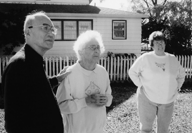Hibakusha—At the End of the World
(“Hibakusha—Sekai no owari ni”) JAPAN / 2003 / Japanese, English, Arabic / Color / 16mm / 116 min
JAPAN / 2003 / Japanese, English, Arabic / Color / 16mm / 116 min
Director, Script, Narrator: Kamanaka Hitomi
Photography: Iwata Makiko, Ietsuka Makoto
Editing: Kamanaka Hitomi, Matsuda Yoshiko
Sound: Kawasaki Koichi
Music: Christoph Heemann
Producers: Koizumi Shukichi, Kawaida Hiroyuki
Production Company, Source: Group Gendai Films Co., LTD.
Trust Shinjuku Bldg. 4F 1-11-13 Shinjuku, Shinjuku-ku Tokyo 160-0022 JAPAN
Phone: 81-3-3341-2863 Fax: 81-3-3341-2874
Email: distribution@g-gendai.co.jp URL: www.g-gendai.co.jp
Nuclear radiation spreads around the globe irrespective of national borders. In Iraq, depleted uranium shells from the Gulf War are believed to be causing the numerous cases of leukemia and cancer. In Hiroshima today, over fifty years after the atomic bomb was dropped, victims suffer from residual nuclear radiation. Downwind from the nuclear facility in Hanford, Washington in the U.S., citizens fall ill from radioactive pollution. With no choice but to live on contaminated land, ordinary people fall victim to internal radiation exposure from groundwater and agricultural produce, and their faces of joy and suffering prompt us to contemplate humanity’s future.
 [Director’s Statement] I had never thought of making a film about the atomic bomb or nuclear radiation victims. But when I met children with leukemia in Iraq who were radiation victims, hibakusha, and realized that low doses of radiation undetectable to the eye, nose or ear were slowly eating away their insides, and that its very existence was denied by the scientific communiy, I started thinking about how I could tell this story as it relates to myself, alive. As I met and spoke with hibakusha, new doors opened one after another, revealing clues to the deep karma of humanity. The ingenuity that leads us to split atoms is full of contradictions, and yet is so human. As I embarked on filmmaking guided by Dr. Hida Shuntaro, I became familiar with the world of radiation sickness. It was inevitable that the atomic bombs of fifty-eight years ago and depleted uranium shells of Iraq would transcend space and time and make an appearance in my present-day life. I documented this process, just as it happened. I admit, this is a simple film. Perhaps all I could do was listen to the voices of radiation victims living in the here and now. These people were poisoned by radiation in the course of living their everyday lives, and I wanted to depict them in a place free from ideology or propaganda.
[Director’s Statement] I had never thought of making a film about the atomic bomb or nuclear radiation victims. But when I met children with leukemia in Iraq who were radiation victims, hibakusha, and realized that low doses of radiation undetectable to the eye, nose or ear were slowly eating away their insides, and that its very existence was denied by the scientific communiy, I started thinking about how I could tell this story as it relates to myself, alive. As I met and spoke with hibakusha, new doors opened one after another, revealing clues to the deep karma of humanity. The ingenuity that leads us to split atoms is full of contradictions, and yet is so human. As I embarked on filmmaking guided by Dr. Hida Shuntaro, I became familiar with the world of radiation sickness. It was inevitable that the atomic bombs of fifty-eight years ago and depleted uranium shells of Iraq would transcend space and time and make an appearance in my present-day life. I documented this process, just as it happened. I admit, this is a simple film. Perhaps all I could do was listen to the voices of radiation victims living in the here and now. These people were poisoned by radiation in the course of living their everyday lives, and I wanted to depict them in a place free from ideology or propaganda.
 Kamanaka Hitomi
Kamanaka HitomiCompleted her first independently directed film in 1990, Balinese Days. With the help of a grant from the Agency for Cultural Affairs, joined the National Film Board of Canada. There, she had the opportunity to work on (with both appearances and editing contributions) Canadian director Bruce Gottlieb’s Proposal for Dog Brain. Thereafter, moved to New York and joined Paper Tiger. Returned to Japan in 1995 and went on to direct numerous works including Iwanami Production’s When Disaster Strikes Our Cities (1995), NHK’s Comfort for Maladies of the Soul—What Has Become of the Japanese Family? (1998), Children and the Ravages of War—Iraq Eight Years after the Gulf War, Ende’s Last Will and Testament—Questioning the Origin of Money (1999), and Living with Cancer—Documenting the Hope Provided by Medicine (2001). |
|
• New Asian Currents | Sand and Water | Wellspring | Three-Five People | Homesick | The Circle’s Corner | The Maze of Lanes | Nee Engey—Where Are You | NEW (IMPROVED) DELHI—Director’s Cut | A Night of Prophecy | 150 Seconds Ago | The Ballad of Life | Noah’s Ark | The Old Man of Hara | Dandelion | Hibakusha—At the End of the World | 3rd Vol.2—2 Light House | And Thereafter | Dust Buries Sabuk | Family Project: House of a Father | Edit | Gina Kim’s Video Diary | Ordo | Her and Him Van Leo | The Big Durian | Perpetual Motion | Debris | Hard Good Life | Nail | The Rhythm in Wulu Village | A Short Journey • Jurors | Kim Dong-won | Kawase Naomi • New Asian Currents Special | Part 1 | Part 2 |
